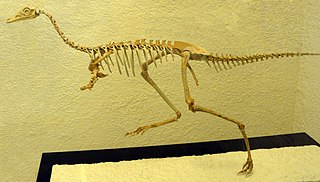
Velociraptor is a genus of dromaeosaurid theropod dinosaur that lived approximately 75 to 71 million years ago during the latter part of the Cretaceous Period. Two species are currently recognized, although others have been assigned in the past. The type species is V. mongoliensis; fossils of this species have been discovered in Mongolia. A second species, V. osmolskae, was named in 2008 for skull material from Inner Mongolia, China.

Deinonychus is a genus of dromaeosaurid theropod dinosaur with one described species, Deinonychus antirrhopus. This species, which could grow up to 3.4 meters (11 ft) long, lived during the early Cretaceous Period, about 115–108 million years ago. Fossils have been recovered from the U.S. states of Montana, Utah, Wyoming, and Oklahoma, in rocks of the Cloverly Formation, Cedar Mountain Formation and Antlers Formation, though teeth that may belong to Deinonychus have been found much farther east in Maryland.

La Brea Tar Pits are a group of tar pits around which Hancock Park was formed in urban Los Angeles. Natural asphalt has seeped up from the ground in this area for tens of thousands of years. The tar is often covered with dust, leaves, or water. Over many centuries, the tar preserved the bones of trapped animals. The George C. Page Museum is dedicated to researching the tar pits and displaying specimens from the animals that died there. La Brea Tar Pits is a registered National Natural Landmark.

Troodontidae is a family of bird-like theropod dinosaurs. During most of the 20th century, troodontid fossils were few and incomplete and they have therefore been allied, at various times, with many dinosaurian lineages. More recent fossil discoveries of complete and articulated specimens, have helped to increase understanding about this group. Anatomical studies, particularly studies of the most primitive troodontids, like Sinovenator, demonstrate striking anatomical similarities with Archaeopteryx and primitive dromaeosaurids, and demonstrate that they are relatives comprising a clade called Paraves.

Oviraptor is a genus of oviraptorid dinosaur that lived in Asia during the Late Cretaceous period. The first remains were collected from the Djadokhta Formation of Mongolia in 1923 during a paleontological expedition led by Roy Chapman Andrews, and in the following year the genus and type species Oviraptor philoceratops were named by Henry Fairfield Osborn. The genus name refers to the initial thought of egg-stealing habits, and the specific name was intended to reinforce this view indicating a preference over ceratopsian eggs. Despite the fact that numerous specimens have been referred to the genus, Oviraptor is only known from a single partial skeleton regarded as the holotype, as well as a nest of about fifteen eggs and several small fragments from a juvenile.

Caudipteryx is a genus of peacock-sized theropod dinosaurs that lived in the Aptian age of the early Cretaceous Period. They were feathered and remarkably birdlike in their overall appearance. Two species have been described; C. zoui, in 1998, and C. dongi, in 2000.

Oviraptoridae is a group of bird-like, herbivorous and omnivorous maniraptoran dinosaurs. Oviraptorids are characterized by their toothless, parrot-like beaks and, in some cases, elaborate crests. They were generally small, measuring between one and two metres long in most cases, though some possible oviraptorids were enormous. Oviraptorids are currently known only from the Late Cretaceous of Asia, with the most well-known species and complete specimens found only in the Gobi Desert of Mongolia and northwestern China.

Shuvuuia is a genus of bird-like theropod dinosaur from the late Cretaceous period of Mongolia. It is a member of the family Alvarezsauridae, small coelurosaurian dinosaurs which are characterized by short but powerful forelimbs specialized for digging. The type species is Shuvuuia deserti, or "desert bird". The name Shuvuuia is derived from the Mongolian word shuvuu (шувуу) meaning "bird".

Alvarezsauridae is a family of small, long-legged dinosaurs. Although originally thought to represent the earliest known flightless birds, a consensus of recent work suggests that they evolved from an early branch of maniraptoran theropods. Alvarezsaurids were highly specialized. They had tiny but stout forelimbs, with compact, bird-like hands. Their skeletons suggest that they had massive breast and arm muscles, possibly adapted for digging or tearing. They had long, tube-shaped snouts filled with tiny teeth. They may have been adapted to prey on colonial insects such as termites.

Byronosaurus is a genus of troodontid dinosaur from the Late Cretaceous Period of Mongolia.

Archaeornithoides is a genus of maniraptoriform theropod dinosaur of the Late Cretaceous of Mongolia.

Citipati is a genus of oviraptorid dinosaur that lived in Asia during the Late Cretaceous period, about 75 million to 71 million years ago. It is mainly known from the Ukhaa Tolgod locality at the Djadokhta Formation, where the first remains were collected during the 1990s. The genus and type species Citipati osmolskae were named and described in 2001. A second species from the adyacent Zamyn Khondt locality may also exist. Citipati is one of the best-known oviraptorids thanks to a number of well-preserved specimens, including individuals found in brooding positions atop nests of eggs, though most of them were initially referred to the related Oviraptor. These nesting specimens have helped to solidify the link between non-avian dinosaurs and birds.

Dinilysia is an extinct genus of snake from the Late Cretaceous (Coniacian) of South America. The snake reached a length of 6–10 feet and preyed on smaller animals. The shape of the animal's skull does support the suggestion that snakes were burrowers during their ancestry; it is clear that Dinilysia was terrestrial.

Tsaagan is a genus of carnivorous dromaeosaurid theropod dinosaur from the Djadokhta Formation of the late Cretaceous of Mongolia.

The rhinoceros iguana is an endangered species of iguana that is primarily found on the Caribbean island of Hispaniola, shared by Haiti and the Dominican Republic. The largest of the Cyclura, they vary in length from 60 to 136 centimetres, and skin colours range from a steely grey to a dark green and even brown. Their name derives from the bony-plated pseudo-horn or outgrowth which resembles the horn of a rhinoceros on the iguana's snout.

Armandisaurus explorator is an extinct species of iguanid that lived in what is now Santa Fe County, New Mexico, in the Early Middle Miocene period. The fossil specimen is a well-preserved cranium with mandibles and parts of seven cervical vertebrae collected by J. C. Blick in 1940. Fossil evidence suggests that A. explorator was a blunt, medium-sized iguana that grew to about 61 cm (24 in) including its tail.

Xiongguanlong is a genus of tyrannosauroid dinosaur that lived in the Early Cretaceous of what is now China. The type species is X. baimoensis, described online in 2009 by a group of researchers from China and the United States, and formally published in January 2009. The genus name refers to the city of Jiayuguan, a city in northwestern China. The specific name is derived from bai mo, "white ghost", after the "white ghost castle", a rock formation near the fossil site. The fossils include a skull, vertebrae, a right ilium and the right femur. The rocks it was found in are from the Aptian to Albian stages of the Cretaceous, between 125 and 100 million years ago.

Linheraptor is a genus of dromaeosaurid dinosaur which lived in what is now China in the Late Cretaceous. It was named by Xu Xing and colleagues in 2010, and contains the species Linheraptor exquisitus. This bird-like dinosaur was less than 2 m (6.5 ft) long and was found in Inner Mongolia. It is known from a single, nearly complete skeleton.
Ovoo gurvel is an extinct monitor lizard from the Late Cretaceous of Mongolia. It is one of the smallest and earliest monitor lizards. It was described in 2008. Ovoo possesses a pair of two small bones in its skull that are not seen in any other lizard.

Vadasaurus is an extinct genus of rhynchocephalian closely related to the aquatic pleurosaurids. Although this genus was not as specialized as the eel-like pleurosaurs for aquatic life, various skeletal features support the idea that it had a semiaquatic lifestyle. The type species, Vadasaurus herzogi, was described and named in 2017. It was discovered in the Solnhofen Limestone in Germany, which is dated to the Late Jurassic. The generic name "Vadasaurus" is derived from "vadare", which is Latin for "to go" or "to walk forth", and "saurus", which means "lizard". "Vadare" is the root of the English word "wade", which is the reason it was chosen for this genus, in reference to its perceived semiaquatic habits. The specific name, "herzogi", refers to Werner Herzog, a Bavarian filmmaker.



















